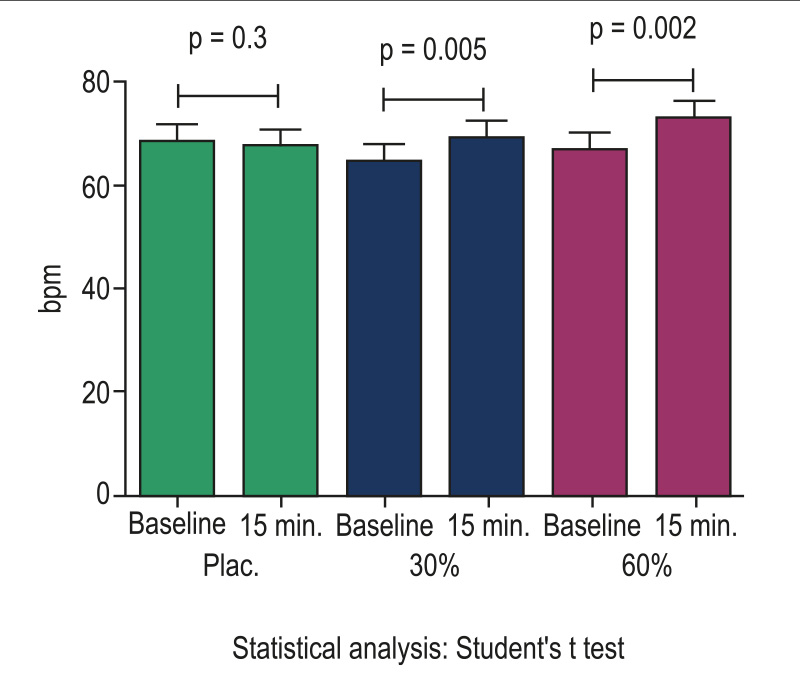Volume 114, Nº 4, April 2020
DOI: https://doi.org/10.36660/abc.20180375
ORIGINAL ARTICLE
Controlled Study of Central Hemodynamic Changes in Inspiratory Exercise with Different Loads in Heart Failure
Luana de Decco Marchese
Sergio Chermont
Danielle Warol
Lucia Brandão de Oliveira
Sabrina Bernardez Pereira
Mônica Quintão
Evandro Tinoco Mesquita

Figure 2 – HR behavior before and at 15 min. of IE with the different loads. HR: heart rate; IE: inspiratory exercise; bpm: beats per minute; plac: placebo; min: minutes. (Source: The author)
Abstract
Background: Inspiratory muscle weakness contributes to exercise intolerance and decreased quality of life in patients with heart failure. Studies with inspiratory muscle training show improvement in inspiratory muscle strength, functional capacity and quality of life. However, little is known about the central hemodynamic response (CHR) during inspiratory exercise (IE).
Objective: To evaluate CHR in a single IE session with different loads (placebo, 30% and 60%) in heart failure.
Methods: Randomized placebo-controlled clinical trial in patients with heart failure with reduced ejection fraction, functional class II and III. Twenty patients aged 65 ± 11 years completed a single session of inspiratory exercise, in 3 cycles of 15 minutes, with a 1-hour washout, involving loads of 30% (C30), 60% (C60) and placebo, using a linear load resistor (PowerBreathe Light). The noninvasive hemodynamic study was performed by cardiothoracic bioimpedance (Niccomo™ CardioScreen®). Statistical analysis was performed with Student’s t-test and Pearson’s correlation, and P≤0.05 was considered significant.
Results: An increase in heart rate (HR) was observed with C30 (64 ± 15 vs 69 ± 15 bpm; p = 0.005) and C60 (67 ± 14 vs 73 ± 14 bpm, p = 0.002). A decrease was observed in systolic volume (SV) with C30 (73 ± 26 vs 64 ± 20 ml; p = 0.004). Cardiac output (CO), on its turn, increased only with C60 (4.6 ± 1.5 vs 5.3 ± 1.7 l/min; p = -0.001).
Conclusion: When using the 60% load, in a single IE session, changes in CHR were observed. HR and CD increased, as did the Borg scales and subjective sensation of dyspnea. The 30% load reduced the SV. (Arq Bras Cardiol. 2020; 114(4):656-663)
Keywords: Heart Failure; Muscle Weaknerss; Breathing Exercises; Hemodynamics; Fatigue Syndrome, Chronic; Fatigue Syndrome, Chronic; Quality of Life; Exercise Therapy; Exercise Movement Techniques.















